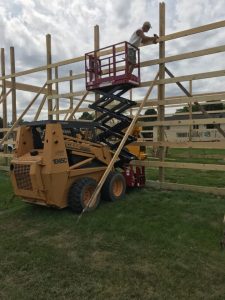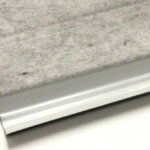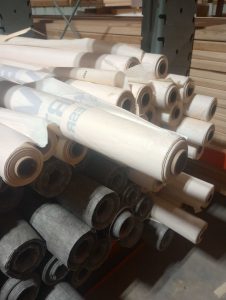Ready to get your head deeper into the dirt? Stick with me here and I’ll explain at the end why this is so important. Here we go….
The Proctor, or Modified Proctor Test, determines the maximum density of a soil needed for a specific job site. The test first determines the maximum density achievable for the materials and uses this figure as a reference. Secondly, it tests the effects of moisture on soil density. The soil reference value is expressed as a percentage of density. These values are determined before any compaction takes place to develop the compaction specifications. Modified Proctor values are higher because they take into account higher densities needed for certain types of construction projects. Test methods are similar for both tests.
 If hired, a soils engineer will probably perform either a sand cone or a nuclear density test. In the sand cone, a small hole (6″ x 6″ deep) is dug in the compacted material to be tested. The soil is removed and weighed, then dried and weighed again to determine its moisture content. A soil’s moisture is figured as a percentage. The specific volume of the hole is determined by filling it with calibrated dry sand from a jar and cone device. The dry weight of the soil removed is divided by the volume of sand needed to fill the hole. This gives us the density of the compacted soil in lbs per cubic foot. This density is compared to the maximum Proctor density obtained earlier, which gives us the relative density of the soil which was just compacted.
If hired, a soils engineer will probably perform either a sand cone or a nuclear density test. In the sand cone, a small hole (6″ x 6″ deep) is dug in the compacted material to be tested. The soil is removed and weighed, then dried and weighed again to determine its moisture content. A soil’s moisture is figured as a percentage. The specific volume of the hole is determined by filling it with calibrated dry sand from a jar and cone device. The dry weight of the soil removed is divided by the volume of sand needed to fill the hole. This gives us the density of the compacted soil in lbs per cubic foot. This density is compared to the maximum Proctor density obtained earlier, which gives us the relative density of the soil which was just compacted.
Nuclear Density meters are a quick and fairly accurate way of determining density and moisture content. The meter uses a radioactive isotope source (Cesium 137) at the soil surface (backscatter) or from a probe placed into the soil (direct transmission). The isotope source gives off photons (usually Gamma rays) which radiate back to the mater’s detectors on the bottom of the unit. Dense soil absorbs more radiation than loose soil and the readings reflect overall density. Water content can also be read, all within a few minutes. A relative Proctor density with the compaction results from the test.
The soil modulus or soil stiffness test is a field-test method which is a very recent development replacing soil density testing. Soil stiffness is the ratio of force-to-displacement. Testing is done by a machine that sends vibrations into the soil and then measures the deflection of the soil from the vibrations. This is a very fast, safe method of testing soil stiffness. Soil stiffness is the desired engineering property, not just dry density and water content. This method is currently being researched and tested.
OK, “so why should I care about this?” you are asking me. Because if you have soil which is fairly expansive, when it gets wet, it will absorb lots of moisture and it expands. These types of soils are very susceptible to frost heaves. Take the soil from my lovely wife’s home, located about 90 miles south of Fargo, ND. You pick up a handful and experience smooth, soft rich soil – true “black dirt” of South Dakota. Look around at all the land in the summertime – it stays green with the moisture held in the ground, despite not having frequent rains. (But when it rains, it pours, trust me on that one!) But the bad thing about this soil is – although it’s great for gardens and planting crops, it’s not much for constructing a building on.
And too many folks in areas like this want to just “plant” their new building in their back yard, without even considering the dirt underneath it. When it rains, this soil is like gumbo, unstable and contributing greatly to foundations (and walls) splitting and cracking. In other words, your building’s foundation is only as good as the dirt it sits on. What did I do to “fix” the expansive soil for my new pole building? I had it replaced and compacted it…heavily. Its now seven years and the concrete floor is still smooth as the day it was put in.








